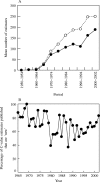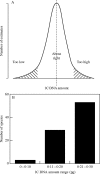Nuclear DNA amounts in angiosperms: progress, problems and prospects
- PMID: 15596457
- PMCID: PMC4246708
- DOI: 10.1093/aob/mci003
Nuclear DNA amounts in angiosperms: progress, problems and prospects
Abstract
Background: The nuclear DNA amount in an unreplicated haploid chromosome complement (1C-value) is a key diversity character with many uses. Angiosperm C-values have been listed for reference purposes since 1976, and pooled in an electronic database since 1997 (http://www.kew.org/cval/homepage). Such lists are cited frequently and provide data for many comparative studies. The last compilation was published in 2000, so a further supplementary list is timely to monitor progress against targets set at the first plant genome size workshop in 1997 and to facilitate new goal setting.
Scope: The present work lists DNA C-values for 804 species including first values for 628 species from 88 original sources, not included in any previous compilation, plus additional values for 176 species included in a previous compilation.
Conclusions: 1998-2002 saw striking progress in our knowledge of angiosperm C-values. At least 1700 first values for species were measured (the most in any five-year period) and familial representation rose from 30 % to 50 %. The loss of many densitometers used to measure DNA C-values proved less serious than feared, owing to the development of relatively inexpensive flow cytometers and computer-based image analysis systems. New uses of the term genome (e.g. in 'complete' genome sequencing) can cause confusion. The Arabidopsis Genome Initiative C-value for Arabidopsis thaliana (125 Mb) was a gross underestimate, and an exact C-value based on genome sequencing alone is unlikely to be obtained soon for any angiosperm. Lack of this expected benchmark poses a quandary as to what to use as the basal calibration standard for angiosperms. The next decade offers exciting prospects for angiosperm genome size research. The database (http://www.kew.org/cval/homepage) should become sufficiently representative of the global flora to answer most questions without needing new estimations. DNA amount variation will remain a key interest as an integrated strand of holistic genomics.
Figures




References
-
- Adams MD, Celniker SE, Holt RA, Evans CA, Gocayne JD et al. 2000. The genome sequence of Drosophila melanogaster Science 287: 2185–2195. - PubMed
-
- Akpinar N, Bilaloglu R. 1997. Cytological investigations of certain species of Vicia L. Turkish Journal of Botany 21: 197–207.
-
- Antonius K, Ahokas H. 1996. Flow cytometric determination of polyploidy level in spontaneous clones of strawberries. Hereditas 124: 285.
-
- APG II. 2003. An update of the Angiosperm Phylogeny Group classification for the orders and families of flowering plants. Botanical Journal of the Linnean Society 141: 399–436.
-
- Arabidopsis Genome Initiative. 2000. Analysis of the genome sequence of the flowering plant Arabidopsis thaliana Nature 408: 796–815. - PubMed
Publication types
MeSH terms
Substances
LinkOut - more resources
Full Text Sources
Miscellaneous

